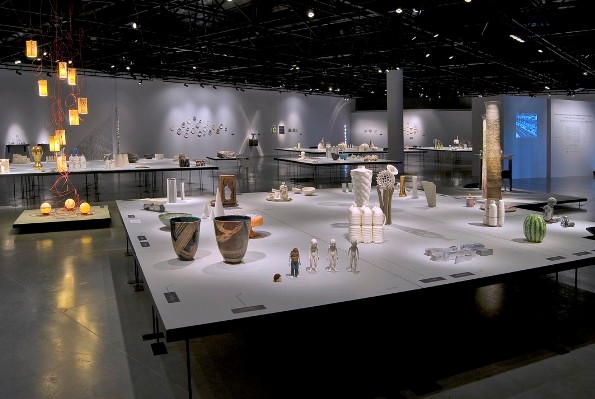
The Sixth Biennale for Israeli Ceramics currently on display at the Eretz Israel Museum; is contained within a single room, yet the paths for exploration within this exhibit are endless. In Ceramic Design: Techno.Logical Implements, Curator Shlomit Bauman, with Technical Ceramics Curator Efrat Friedland and Design Mill, have mounted an exhibit with enormous aesthetic appeal, an experience for the senses and intellect, inviting, challenging and thought-provoking.
As Bauman explains, “there is no hierarchy within the exhibit”; the exhibit includes works by well known ceramic artists and newer names on the scene, as well as examples of technical ceramics displayed in transparent cases with explanatory texts alongside the art works. Surveying the room, the aesthetic impact is immediate and powerful – it is an excellently designed exhibit, ceramicists and laypeople alike can easily spend a couple of hours walking from one piece to another, admiring the aesthetics and craftsmanship.
Bauman, a ceramicist and curator who holds a Masters Degree in Industrial Design from the Technion, to is attuned to the philosophical and political aspects of technology in her approach to the Biennale, saying, “Sometimes technology is hidden beneath the surface. The encounter between art and methods is not just through implements and tools, there is a relationship between technology and the creation of ideologies and social structures.” As an example, Bauman cites the cell phone, an instrument whose use is immediate and concrete, yet has had enormous social impact.
The exhibit examines this relationship between technological change and social processes in different ways. Bauman has chosen to open the exhibit with a video filmed by Shimon Bader, Chief Designer at the Naaman Ceramics Factory (1938 – 1996) a year before the factory shut down. This view of the Israeli ceramics industry, which no longer exists, establishes the connection between the individual and historic, social, economic processes, art and industry. Israeli ceramic artists enjoyed a cooperative relationship with the local ceramics industry, often using their larger facilities when creating works that an individual studio was not equipped to accommodate.
Creating in a changing world, the exhibit reflects a dialogue with craft traditions of the past and the digital, industrial present. Some employ industrial ceramics that are manipulated or incorporated into the art work, others are emphatically hand made; many incorporate a variety of techniques and materials.
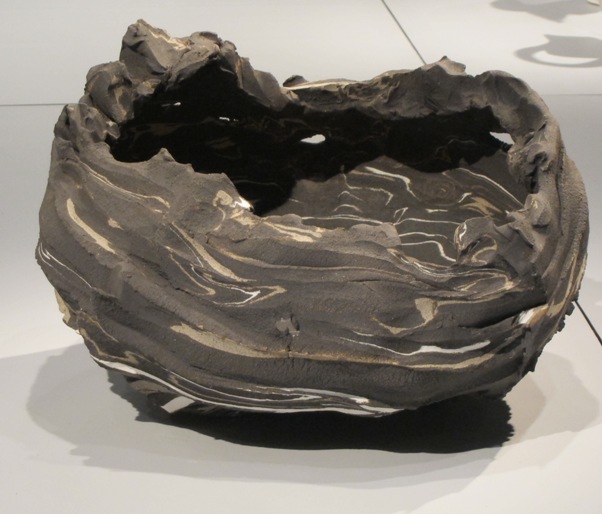
Esther Beck’s Turbulence in Black, is a work with powerful presence, its rough form created by the artist striking the piece with a hammer. Curator Bauman also related that Avner Singer’s Two Chimneys stood unfired for two years because he did not have a kiln large enough to accommodate the pieces. Ultimately, he built a structure for firing around the two forms. Irit Abba, winner of the 2009 Andy Prize, presents a different perspective on the relationship of materials to form with her Leftovers of a Vessel, created from colored porcelain shards and silicon. A beautiful vessel, the material itself (for those who had the privilege to examine a sample in a preview tour – the finished object is not to be touched) is surprisingly flexible.
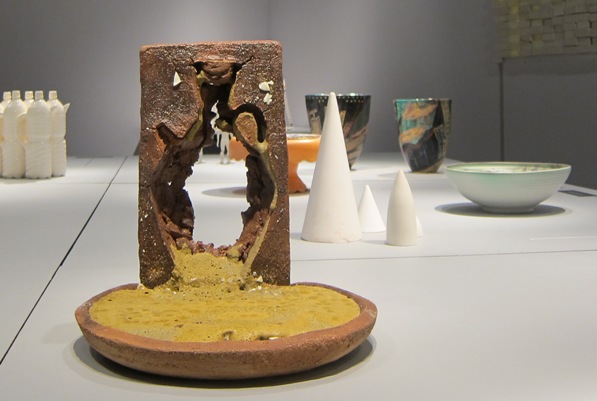
Several works reflect the connection between the past – social and artistic – and the present, in different ways. Ayala Bougay’s A Jug in Low Resolution references classical Greek clay vessels in contemporary pixellated form, with humorous effect. In a similar manner, Noam Bar Yochai’s Ming, spells out the word in LED lighting across an earthenware vessel whose form recalls the traditional vase. Another direction entirely is indicated in Miri Fleischer’s Nakba, which was made by inserting a Palestinian jug within another clay form and firing them at a heat which melted the jug within, leaving only a fragmented outline of the lost jug. Naama Zussman’s delicate plates printed with texts – “What I did not remember I could not be held responsible for” – provide food for thought. Evoking a deceptive sense of fragility in their thin, wavering edges, undercut by the knowledge that porcelain is quite a strong material, and resistant to high temperatures.
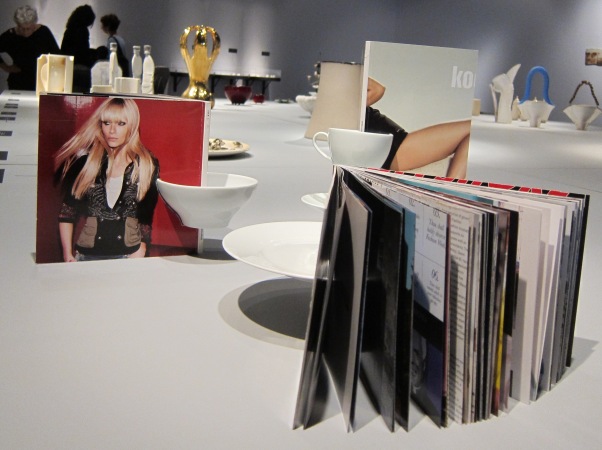
Many works relate to popular culture and mass produced items, material and ideological. Sahar Batsry’s Representative Cross Section is made of industrial ceramic cups bisected with fashion magazines. Gad Charny’s Endless Column no. 3 is made of industrial clay cups and compressed mineral water bottles, while Stella Lahav’s earthenware bottles create the ubiquitous familiar shape in clay.
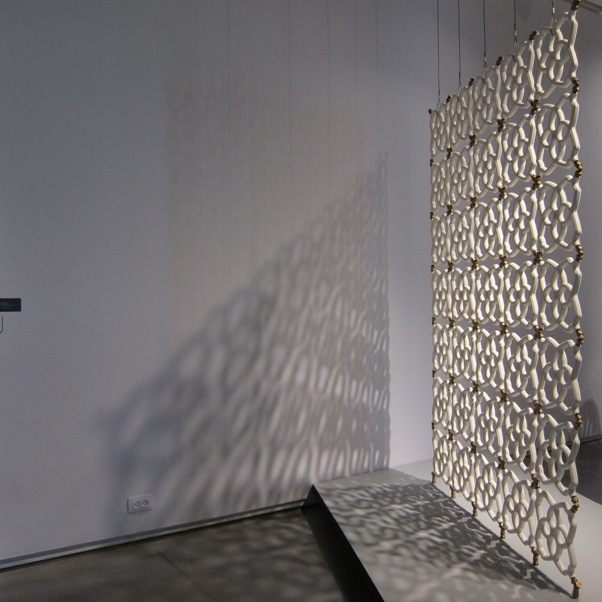
An interesting example of the potential relationships between past and present can be seen in Studio Kahn’s Ecooler, a clay implement for cooling the air utilizing a simple idea: when water is run through the clay pipes, it cools the surrounding air. The innovation here is not in the method, which is an ancient one, but rather in the design, which is decorative, modern and yet references the traditional Arabesque designs.
Yet another option is to take the technical ceramics tour through the room, revealing a wealth of uses in computer technologies, medicine and construction. Although the popular image of ceramics may be of a fragile, easily breakable material, that is not the full story. Heat resistant, non-corrosive and strong, the repertoire of uses for ceramics is ever-expanding, and a stroll through the examples provided in the exhibit offers an intriguing glimpse into this less widely known aspect of ceramics. Scientific research and technological advances continue to improve and develop ceramic compounds with enhanced qualities, expanding the repertoire of ceramics. Ceramic components are used in a wide range of fields, replacing other materials, as in the wafers used for the disc platform in the semi-conductor industry, where the burning process involves mixing chemicals at high temperatures, or ceramic knives and pliers.
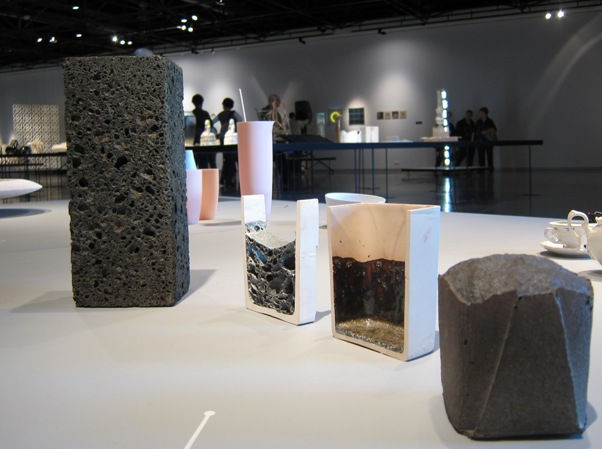
The potential inherent in the encounter between science, technology and design can be seen in Ori Yekutiel’s LightStone, a foamed material resembling basalt, developed at the Bezalel Academy of Arts and Design Jerusalem as a final project carried out jointly by the Department of Industrial Design and the Department of Ceramic and Glass Design. Through a process of melting basalt they arrived at a material with the following properties: lightweight, constructive, acoustic insulation, resistant to high temperatures and with the capacity of incorporating it into other ceramic bodies with which it came in contact during the firing. Yekutiel’s design will also be on display at the Bezalel “Thinking Hands” exhibit during Milan Design Week, April 12 – 17, 2011.
It is a hopeless endeavor to encompass the many aspects of this exhibit in a single article, or a single visit. The exhibit will remain open through June 15, 2011, which leaves ample time for return visits – much recommended. Eretz Israel Museum, 2 Haim Levanon Street, Tel Aviv, 03-6415244.






Comments are closed.